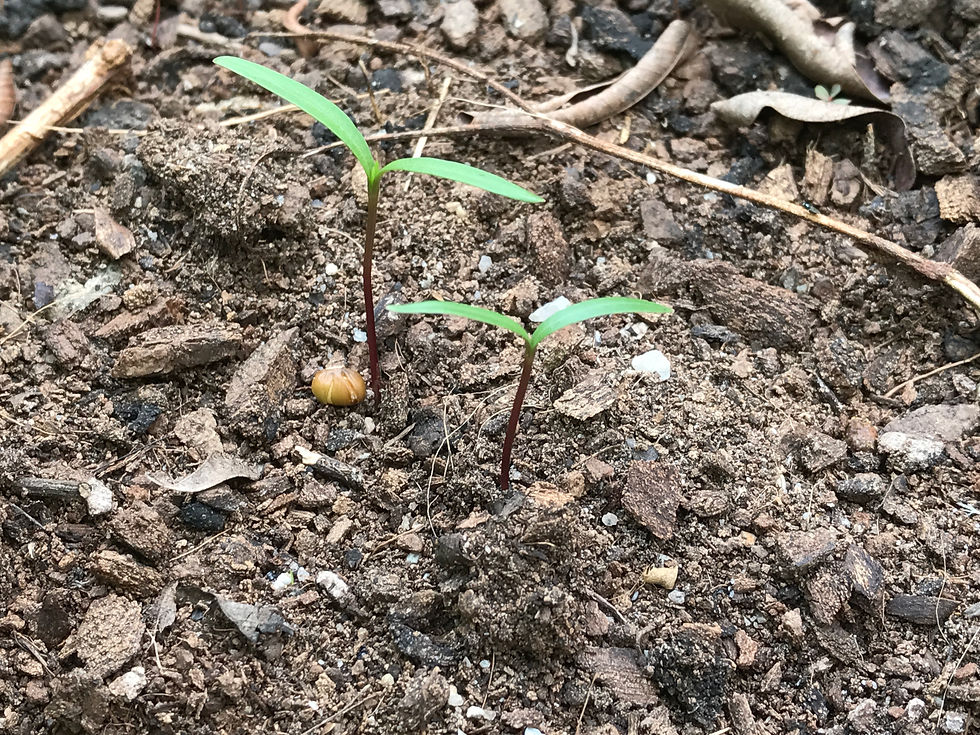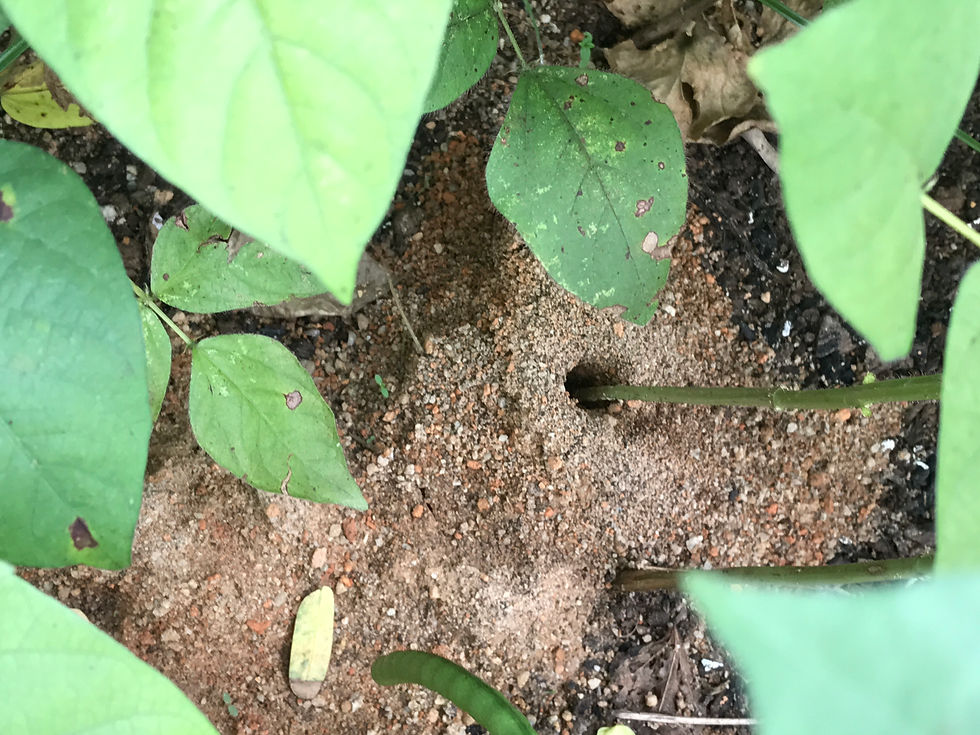Garden in M'sia (Day 80)
- kanimaranjandu
- Dec 3, 2017
- 5 min read

Above: Looks like a blue rose. (Clitoria ternatea, double petalled variety)
Previously
Updates between Day 59 and Day 80 (02-12-2017)
-Got cuttings of Longevity spinach (Gynura procumbens) and Indian Borage (Plectranthus amboinicus)
-Got seeds of Sessile joyweed (Alternanthera sessilis), Marigold (Tagetes sp.), Cosmos (Cosmos sp.), Cat's whiskers (Orthosiphon aristatus) and Sea Hibiscus (Talipariti tiliaceum).
-Peanuts (Arachis hypogaea) began flowering.
-Mung beans (Vigna radiata) and Black-eyed peas (Vigna unguiculata) declining.
Aphids, spider mites, thrips, mealybugs, seed bugs (Riptortus spp.). The overwhelming quantity of these plant feeding arthropods seems to have taken a serious toll on the cover crops on the main plot. They have ravaged much of the bean plants. Not to mention the various species of ants (at least 5; with the main culprit being possibly Carebara diversa) protecting the aphids and mealybugs from predators.

Above: A juvenile Riptortus sp. which looks strikingly like an ant. Could be a form of Batesian mimicry.
Below: An adult Riptortus sp. seed bug.

Now, I feel that these 'pests' are part of a complete system. Without them, the array of predators, parasitoids and symbionts would be less successful. I am accepting of them, and am actually fascinated and curious to see the interactions between them and other animals and plants; basically ecology. This project is an experiment and learning experience anyways, and since I am not growing plants for their commercial value, I am not bothered by the fact that the garden is plagued by these insects and mites.
Anyways, there were plenty, and I mean PLENTY, of beneficial arthropods too. I was immediately greeted by hoverflies upon entry into the garden, just like on my last visit. I saw at the very least 5 juvenile Asian Ant Mantids (Odontomantis planiceps), 15 Scymnus ladybird larvae, 1 adult Scymnus ladybird, 5 Cheilomenes sexmaculata ladybird larvae, 1 adult Cheilomenes sexmaculata ladybird, 1 lynx spider (Oxyopidae), 1 Nomia bee, 3 Cycad blue butterflies (Chilades pandava), 2 adult hoverflies (Syrphidae) and 1 hoverfly larva. Oh and I saw a parasitoid wasp in action! The tiny beige wasp was depositing eggs into aphids. Those eggs will eventually hatch and eat the aphids from inside out. Gnarly! A pity I wasn't able to record the action due to the diminutive size of the wasp, but it was cool to watch.

Above: A ladybird larva (Cheilomenes sexmaculata)
Below: A pretty ladybird (Cheilomenes sexmaculata)


Above & below: Pollinators were prevalent too, such as this Nomia bee (above) and the Cycad Blue (Chilades pandava; below)

As for the plants, as mentioned earlier the mung beans and black-eyed peas were on decline, but some new plants were sprouting. The beans were still producing and flowering, and are probably on their last hurrah. A number of bean pods were severely attacked by aphids and Riptortus bugs that the seeds were no longer viable. The leaves of many of the plants were infested with spider mites: as shown here.
The first sunflower had begun to die off. I could see the seeds but they were still soft and wet, guess I have to wait a little while more to harvest them. The soybeans (Glycine max) were also still unripe (It's been a long time!). The butterfly peas (all 4 varieties; blue, white, lilac and blue double-petalled) were blooming, and it was a pretty sight to behold. These plants (Clitoria ternatea) are easy to grow, possibly native (some sources state they are native to Africa), fix nitrogen, are usable in the kitchen (their flowers are used to create natural food colouring and the extract is also said to be very nutritional) and have beautiful blooms. The okra (Abelmoschus esculentus) was getting bigger, marigold had begun sprouting and to my surprise, some corn (Zea mays) had sprouted from the corn cob I threw 21 days prior. Basil (Ocimum basilicum), tomato (Solanum lycopersicum) and chilli (Capsicum annuum) seedlings were also found around the garden.

Above: So that's where sunflower seeds come from. Pretty cool!
In the kitchen plot, the pumpkin plants (Cucurbita pepo) were getting slightly larger, although they were showing signs of yellowing. This could be due to the low sunlight quantity in the area, as compared to the main plot, the kitchen plot gets about 6 hours less direct sunlight per day. But this quality also makes this plot a reasonable place to root seedlings, as we have done or are trying with the Gynura procumbens, Plectranthus amboinicus and some newly brought-in Laksa leaf cuttings (Persicaria odorata). The kitchen plot does receive a good 4 hours of strong sunlight a day still, so that may explain the beautiful Japanese Rose (Portulaca grandiflora) bloom I saw. A peanut plant was flowering too. There were some aphids here, and a few ladybird larvae, but not as plentiful as compared to the main plot. There were a lot more millipedes spotted here however, possibly due to the moister and cooler condition here.

Above: Possibly the highlight of the kitchen plot, this radiating beauty is the Japanese Rose (Portulaca grandiflora)
My parents also bought a young neem tree (Azadirachta indica) and potted it outside one of the windows in hopes of providing some form of cooling to the room.
Looking at the condition of the main plot, I will have to start seeding a new generation of Vigna cover crops. There is a lingering doubt at the back of my mind that feels the beans may not grow too well due to the established populations of aphids and ants, however. Thus, perhaps a transition to letting the butterfly peas spread to serve as the nitrogen fixers may be a smarter move, since the butterfly peas seem to not be affected by the aphids and they are perennial anyways, meaning that, unlike the Vigna beans, they will not decline as soon as they set seed. Declining plants are more susceptible to pests anyways. I will have to cover the soil quickly due to the weeds (especially Kyllinga nemoralis) that seem to have taken root in the bare soil in swift succession. Therefore, I shall not clear the declining beans all at once, or at all, until the new generation is ready to take over.

Above & below: Butterfly pea flowers (Clitoria ternatea), lilac (below) and white (above) varieties.


Above: Tomato (Solanum lycopersicum) seedlings.
Below: Marigold (Tagetes sp.) seedlings with their tell-tale red stems and linear cotyledon leaves.


Above: Sweet basil (Ocimum basilicum) seedlings.
Below: Okra (Abelmoschus esculentus) getting mature.


Above: Ant nest (Carebara diversa). The ants actually help to turn the soil, making them quite beneficial actually.
Below: The young neem 'tree' (Azadirachta indica)


Above: Overview of main plot.
Below: Overview of kitchen plot.


Above: Adios! (A ladybird pupa, Cheilomenes sexmaculata, with some aphids and a Camponotus ant)

Comments